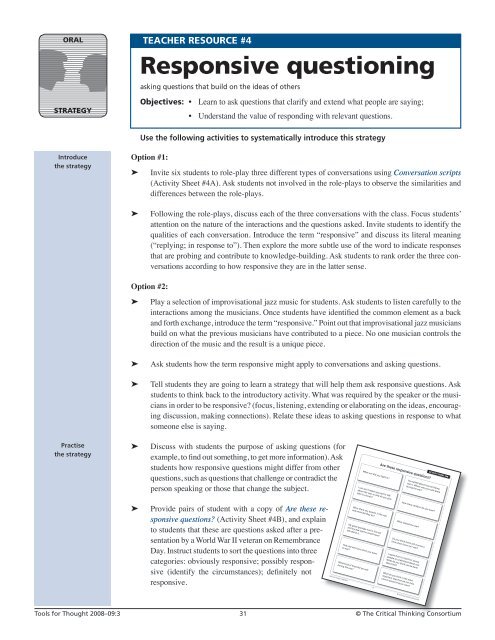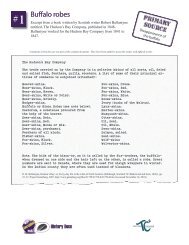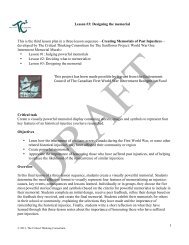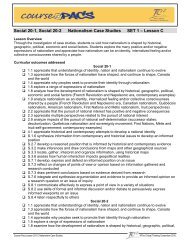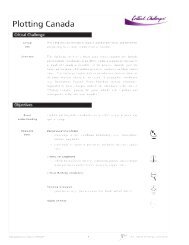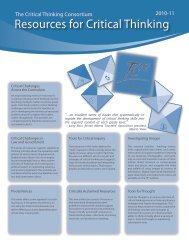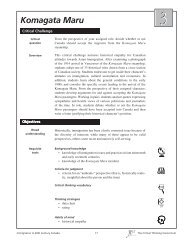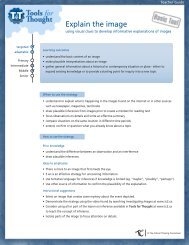Inquiry-mindedness - The Critical Thinking Consortium
Inquiry-mindedness - The Critical Thinking Consortium
Inquiry-mindedness - The Critical Thinking Consortium
Create successful ePaper yourself
Turn your PDF publications into a flip-book with our unique Google optimized e-Paper software.
ORALSTRATEGYTEACHER RESOURCE #4Responsive questioningasking questions that build on the ideas of othersObjectives: • Learn to ask questions that clarify and extend what people are saying;• Understand the value of responding with relevant questions.Use the following activities to systematically introduce this strategyIntroducethe strategyOption #1:➤➤Invite six students to role-play three different types of conversations using Conversation scripts(Activity Sheet #4A). Ask students not involved in the role-plays to observe the similarities anddifferences between the role-plays.➤➤Following the role-plays, discuss each of the three conversations with the class. Focus students’attention on the nature of the interactions and the questions asked. Invite students to identify thequalities of each conversation. Introduce the term “responsive” and discuss its literal meaning(“replying; in response to”). <strong>The</strong>n explore the more subtle use of the word to indicate responsesthat are probing and contribute to knowledge-building. Ask students to rank order the three conversationsaccording to how responsive they are in the latter sense.Option #2:➤➤➤➤➤➤Play a selection of improvisational jazz music for students. Ask students to listen carefully to theinteractions among the musicians. Once students have identified the common element as a backand forth exchange, introduce the term “responsive.” Point out that improvisational jazz musiciansbuild on what the previous musicians have contributed to a piece. No one musician controls thedirection of the music and the result is a unique piece.Ask students how the term responsive might apply to conversations and asking questions.Tell students they are going to learn a strategy that will help them ask responsive questions. Askstudents to think back to the introductory activity. What was required by the speaker or the musiciansin order to be responsive? (focus, listening, extending or elaborating on the ideas, encouragingdiscussion, making connections). Relate these ideas to asking questions in response to whatsomeone else is saying.Practisethe strategy➤➤Discuss with students the purpose of asking questions (forexample, to find out something, to get more information). Askstudents how responsive questions might differ from otherquestions, such as questions that challenge or contradict theperson speaking or those that change the subject.talks in schools?Are these responsive questions?You talked about how terrifyingWhat war did you fight in?war is. Where was your safe placeduring the war?I can see it makes you sad to talkACTIVITY SHEET #4Babout the war, so why do you give➤➤Provide pairs of student with a copy of Are these responsivequestions? (Activity Sheet #4B), and explainto students that these are questions asked after a presentationby a World War II veteran on RemembranceDay. Instruct students to sort the questions into threecategories: obviously responsive; possibly responsive(identify the circumstances); definitely notresponsive.Were there any women in the warand what did they do?My great-grandpa was in the warand my dad says he would nevertalk about it.How old were you when you wentto war?What kind of food did you eatduring the war?How many children do you have?What started the war?Do you think there will ever be atime when there isn’t war?I agree that it is hard for youngpeople to understand about war.What do you think can be doneabout this?What do you think is the mostimportant step that we can takenow to prevent future wars?Tools for Thought 2008-09:3 35 © <strong>The</strong> <strong>Critical</strong> <strong>Thinking</strong> <strong>Consortium</strong>Tools for Thought 2008–09:3 31 © <strong>The</strong> <strong>Critical</strong> <strong>Thinking</strong> <strong>Consortium</strong>


